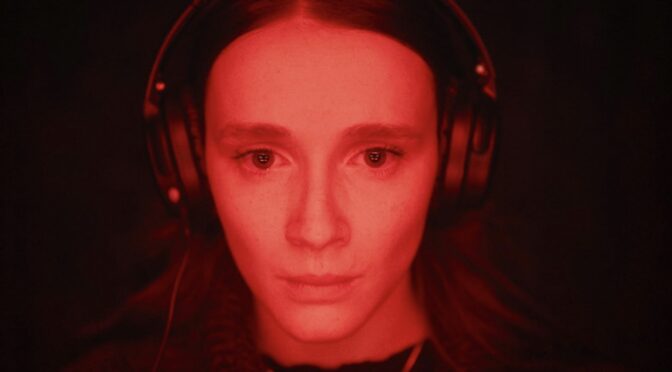Pascal Plante takes aim at the media and our obsession with true crime in this psychological drama. Claustrophobic sets and saturated blues lace the atmosphere with expressionist paranoia. The sociopathic protagonist at the film’s core builds alienation with a probing camera that constantly looks but never fully reveals the mysteries in its gaze.
When it comes to the lingering camera shot, there are few things more compelling than the blank face: a face that remains still, impassive and inscrutable. RED ROOMS provides us with copious examples of such shots, particularly those of anti-hero Kelly-Anne as she sits silently in a courtroom, becoming increasingly obsessed with the case of a man accused of three gruesome murders. All the killings take place within the ‘red rooms: torture chambers where the acts are recorded and sold to the highest bidder. Kelly Anne (Juliette Gariépy) spends her downtime eviscerating her opponents in online poker, providing eccentric poses for a modelling company, and occasionally indulging in bizarre exercise routines within her minimalist flat.
As Kelly-Anne stares at her screen, the camera constantly avoids the scenery, focusing on her face watching these unfolding events, with her inscrutable facial expressions hinting at ambitions we’re never allowed to know. It’s easy to liken her to previous sociopaths of cinema like A CLOCKWORK ORANGE’s Alex DeLarge as he leers at the camera or NIGHCRAWLER’s unhinged Lou Bloom doggedly hunting for the next crime scene. However, Kelly-Anne’s concentrated, meticulous obsession leans further toward the more recent CENSOR’s Enid with the slow descent into madness and unreality. Plante makes it clear from the off that Kelly-Anne is no normal human being, waking up as if from extended hibernation, with her home saturated in a ghostly blue. Lights could probably be turned on if she fancied it, but the flat remains in gloom throughout the narrative, with only the screens providing a source of light. Sharp edits see her switching from night to day instantly as she prepares to haunt the courtroom with her silent presence.
“…the camera remains fixated on Kelly-Anne, who refuses to provide any easy, expositional monologues about her motivations.”
The film’s glacial pacing – along with its equally icy lead – won’t work for everyone. Other characters float around the narrative, but the camera remains fixated on Kelly-Anne, who refuses to provide any easy, expositional monologues about her motivations. While violence remains a central theme throughout, Plante never allows the plot to slip into exploitation territory, with the ‘red rooms’ themselves never shown. We hear the screams of the victims as the videos play, but we are never permitted to see the atrocities.
As with all good thrillers and horrors (RED ROOMS might be billed as a psychological thriller, but its visuals, screeching violins and amoral protagonist all lean into the realm of horror), terror is cultivated by what we are not shown. If you’re willing to lean into the expressionist side of things and be patient with the slowly unfolding events, RED ROOMS is worth a visit.

